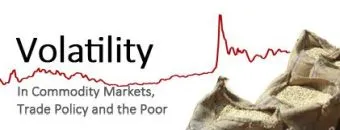What is volatility?
Volatility describes price fluctuation around a long-term trend. After a long period of low and stable prices, food price levels increased in 2007 and 2008 and remain volatile. Excessive volatility – sudden and extreme food price shocks – threatens in particular the food security of poor people who spend 60-70 percent of their income on food. As they lack financial resources and buffer mechanisms, calorie intake and the quality of the diet (with respect to micronutrients) are reduced with long-lasting impacts for health, motoric and mental development for children. Excessive price shocks make production, investments, storage and trade more complex as uncertainty about future prices increases.
How do changes in food prices affect food security?
Stability as the cross-cutting dimension defining food security directly impacts availability, access and utilization of food through e.g. natural disasters, civil wars or changes in trade policies. These can cause market instability and subsequently abrupt food price changes, which influences food security directly through nutrition-related channels and indirectly through real income fluctuations.
The nutrition-related channels can be divided into two types: real income effect and substitution effect.
- The real income effect usually results in a decrease in calorie intake.
- Substitution effect can lead to switching to lower-quality food consumption and as a result lower intake of essential micronutrients like vitamin A, iron, or zinc that are necessary for body growth and body development.
The indirect effect of the real income changes can be due to changes in childcare, health expenditures or physical access to healthcare. Price changes may also affect households’ long-term wealth due to coping strategies like asset liquidation, going into debt, or taking children out of school. The total impact of these different channels on food security depends on cultural factors, diet preferences and socio-economic factors as well as on the changes of other relevant prices, formal or informal insurance mechanisms and government policies and aid programs. Our research aims to evaluate the impact of price changes and price volatility on food security and to provide timely information on threats to food security.
Further information
The links below provide further relevant information about food price volatility:
The Economics of Grain Price Volatility



